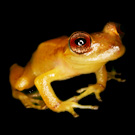
|
 |
 |
 |
 |
 |
 |
 |
 |  |
 |
 |
Merkmale |
Länge 10-15 cm, in Ausnahmefällen bis zu 20 cm und 0,5 kg Gewicht. In Südbrasilien, aber auch Europa eingeschleppte Art. Trommelfell sehr groß, beim Männchen etwa doppelter Augendurchmesser, beim Weibchen 1-1,5-facher Durchmesser; dadurch gut von einheimischen Grünfröschen zu unterscheiden. Männchen mit kehlständiger Schallblase. Oberseite grün, braun oder oliv, mit schwarzen oder braunen Flecken. Unterseite weiß, mit grauen Flecken. |
 |
 |  |  |
 |
 |
Verbreitung |
Ursprünglich im Osten Nordamerikas, aber heute in viele Teile der Welt verschleppt und ein Problem darstellend, z.B. in Brasilien und Europa. In Deutschland in der Oberrheinebene in Ausbreitung begriffen. |
 |
 |  |  |
 |
 |
Lebensraum |
Größere stehende und langsam fließende Gewässer mit warmen, sonnenexponierten Bereichen. Immer in Gewässernähe. Überwinterung im Schlamm. |
 |
 |  |  |
 |
 |
Biologie |
Tag- und nachtaktiv. Legt bis zu 20000 Eier und stellt eine große Gefahr für andere Amphibien dar, da Nahrungskonkurrent und direkter Fressfeind. |
 |
 |  |  |
 |
 |
Literatur |
Batista, C. G. (2002). Rana catesbeiana. Effects on native anuran community. Herpetol. Rev. 33(2): 131.
Bee, M. A. and H. C. Gerhardt (2001). Neighbor-stranger discrimination by territorial male bullfrogs (Rana catesbeiana): I. Acoustic basis. Animal Behav. 62: 1129-1140.
Bee, M. A. and H. C. Gerhardt (2001). Neighbor-stranger discrimination by territorial male bullfrogs (Rana catesbeiana): II. Perceptual basis. Animal Behav. 62(1141-1150).
Collins, J. P. (1979). Intrapopulation variation in the body size at metamorphosis and timing of metamorphosis in the bullfrog, Rana catesbeiana. Ecology 60(4): 738-749.
Currie, W. and E. D. Bellis (1969). Home range and movements of the bullfrog, Rana catesbeiana Shaw, in an Ontario pond. Copeia 1969(4): 688-692.
Emlen, S. T. (1968). Territoriality in the bullfrog, Rana catesbeiana. Copeia 1968(2): 240-243.
Goodyear, C. P. (1971). Orientation of bullfrogs (Rana catesbeiana) during metamorphosis. Copeia 1971(2): 362-364.
Guix, J. C. (1990). Introdução e colonização de Rana catesbeiana Shaw, 1802 em um pequeno vale no municipio de Suzano (SP), sudeste do Brasil. Grupo Estud. Ecol. Ser. Doc. 2: 32-34.
Kwet, A. (1999b). Biologie von Phyllomedusa iheringii und Bemerkungen zu dieser Gattung in Rio Grande do Sul, Südbrasilien (Anura: Hylidae: Phyllomedusinae). Salamandra 35(1): 19-36.
Nie, M., J. D. Crim, et al. (1999). Disolved oxygen, temperature, and selection by bullfrog (Rana catesbeiana) tadpoles. Copeia 1999(1): 153-162.
Silva Abes, S. (1995). Competidores e predadores de Rana catesbeiana (Amphibia, Anura) no ranário Sâo Joaquim, Colina-SP. Resumos do XXI Congresso Brasileiro de Zoologia: 184-185.
Steinwascher, K. (1978). The effect of coprophagy on the growth of Rana catesbeiana tadpoles. Copeia 1978(1): 130-134.
Wienandt, T. A. (1969). Vocalization, aggressive behavior, and territoriality in the bullfrog, Rana catesbeiana. Copeia 1969(2): 276-285. |
 |
 |
|

